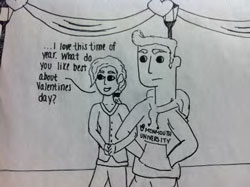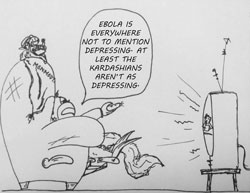Back in 1968, filmmaker George A. Romero redefined zombies from mindless slaves to eternally hungry flesh eaters with Night of the Living Dead (NOTLD) and its sequels. However, Romero’s horror tales didn’t stay confined to celluloid and have transitioned into comics. IDW has adapted Dawn of the Dead and Land of the Dead while Avatar Press keeps Romero’s vision alive with its own “NOTLD” series and specials like “NOTD: Back from the Grave.”
John A. Russo, co-writer of NOTLD, has used his dark imagination to continue offering tales of humans evading the zombie plague. He co-wrote a prequel tale to the 1968 film with writer Mike Wolfer and even created his own NOTLD sequel with the miniseries, “Escape of the Living Dead,” three follow-up tales, and an annual.
In an interview with comicbookresources.com, Wolfer explained what it was like working with Russo to deepen this classic story. “And as I always mention, I’m a fanboy, too, so just the fact that I’ve been given this opportunity to help carve-out new chunks of unwritten history in such a prestigious franchise is incredible,” he said.
While Romero’s night of terror still lingers, other comic publishers have thrown their heads, hands, and feet into the zombie genre. Dynamite Entertainment has two volumes of “Raise the Dead,” horror comic writer and “30 Days of Night” co-creator, Steve Niles, developed a zombie tale set in Reno, Nevada with “Remains” (soon to be a TV movie), and Vertigo features “iZombie” about an undead investigator who eats brains once in a while to survive.
However, the most notable of series has been “The Walking Dead” from Image Comics. Created and written by Robert Kirkman with art from Tony Moore (issues one to six) and Charlie Adlard (issue seven to present), the comic is a dramatic, sophisticated, and unpredictable narrative about humans surviving in a world overrun by the dead. The series was recognized for its achievements in 2010 with an Eisner Award for Best Continuing Series.
Kirkman has never lost his beat from issue to issue as he puts protagonist Rick Grimes, his wife Lori, son Carl, and fellow survivors through the ringer repeatedly, offering salvation only for it to turn into damnation.
While talking with newsarama.com, Kirkman said where the main focus of this series tends to lie. Kirkman said, “In a sense, Carl is the heart and soul of the comic series. He started out as a true innocent, and it’s been a fun exploration to watch the world change around him and for him to see the things he has had to go through. Carl’s had to do a lot to survive. In general, to watch characters deal with hardship and overcoming obstacles shows how it can change them.”
Although these zombie comics appear in Image or Avatar Press, that doesn’t mean DC and Marvel haven’t pitted their heroes against the undead. In DC’s mega-event, “Blackest Night,” many fallen heroes came back as Black Lanterns, wielding the power of death. Meanwhile, Marvel first introduced their zombie character Simon Garth Williams in 1963’s “Menace” #5. Since then, Simon visited the Marvel Universe again with a MAX miniseries and appearances in titles like “Legion of Monsters: Man-Thing” #1.
However, the real undead heart of Marvel’s foray into zombie mayhem is with the “Marvel Zombies” line. First introduced in “Ultimate Fantastic Four” #21, “Marvel Zombies” ventures into an alternate world where both heroes and villains have transformed into super beings with a craving for human flesh.
Currently, there are five “Marvel Zombies” miniseries, four specials, a graphic novel collecting the zombie covers by Arthur Suydam, a trip to the mainstream Marvel U (“Black Panther” #28 to 30), and one crossover with Evil Dead’s Ash in “Marvel Zombies vs. the Army of Darkness.” Most recently Marvel wrapped “Marvel Zombies Supreme,” where the undead virus infected such heroes as Hyperion and Nighthawk.
“Marvel Zombies 1 and 2,” which mainly focused on this zombie world, were written by Kirkman and drawn by Sean Philips and Suydam (Part 2). “Marvel Zombies 3, 4, and 5,” written by Fred Van Lente and drawn by Kev Walker (Parts 3 and 4) and Jose Angel Cano Lopez (Part 5) featured characters like Machine Man and Morbius, the Living Vampire working with A.R.M.O.R. (Altered-Reality Monitoring and Operational Response) to deal with this zombie mess crossing into our world or venturing into other universes to fight this threat.
In 2008, Van Lente talked to marvel.com about how the third “Marvel Zombies” series would differ from Kirkman’s stories. “…another difference with our series is that the MARVEL ZOMBIES series, as the name implies, was where the Marvel Zombies were the ‘good guys’ whereas here in MARVEL ZOMBIES 3 we’re going in a different direction where we’re pitting some ‘normal’ characters against the Marvel Zombies and changing who or what it is you’re rooting for,” Van Lente said.
Overall, these and many other zombie comics show that the desire to tell more stories about the living dead (and super living dead) continues to grow swiftly just like a zombie virus itself.




